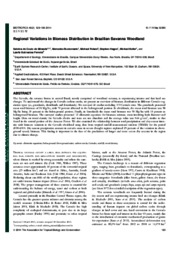Regional Variations in Biomass Distribution in Brazilian Savanna Woodland.
Regional Variations in Biomass Distribution in Brazilian Savanna Woodland.
Author(s): MIRANDA, S. DO C. DE; BUSTAMANTE, M.; PALACE, M.; HAGEN, S.; KELLER, M.; FERREIRA, L. G.
Summary: The Cerrado, the savanna biome in central Brazil, mostly comprised of woodland savanna, is experiencing intense and fast land use changes. To understand the changes in Cerrado carbon stocks, we present an overview of biomass distribution in different Cerrado vegetation types (i.e., grasslands, shrublands and forestlands). We surveyed 26 studies including 170 Cerrado sites. The grasslands presented mean total biomass of 24 Mg/ha, with 70 percent allocated in the belowground portion. In shrublands, the mean total biomass was 58 Mg/ha being 58 percent in the belowground portion. Finally, in forestlands the mean total biomass was 98 Mg/ha with 18 percent as belowground biomass. The surveyed studies presented 12 allometric equations for biomass estimate, most involving both diameter and height. Data on wood density for Cerrado shrubs and trees are not abundant and the average value was 0.66 g/cm3, similar to that found in the central portion of the Amazon Forest. We also examined the relationship between total precipitation and dry-season intensity with biomass variation in the Cerrado shrubland using data from tropical rainfall measurement mission (TRMM) for the period 2000?2010. Dry-season precipitation amount in cerrado areas in severe drought regions explained 29 percent of the variation in aboveground woody biomass. This finding is important in the face of the predictions of longer and more severe dry seasons in the region due to climate change.
Publication year: 2014
Types of publication: Journal article
Unit: Embrapa Territorial
Observation
Some of Embrapa's publications are published as ePub files. To read them, use or download one of the following free software options to your computer or mobile device. Android: Google Play Books; IOS: iBooks; Windows and Linux: Calibre.
Access other publications
Access the Agricultural Research Database (BDPA) to consult Embrapa's full library collection and records.
Visit Embrapa Bookstore to purchase books and other publications sold by Embrapa.

